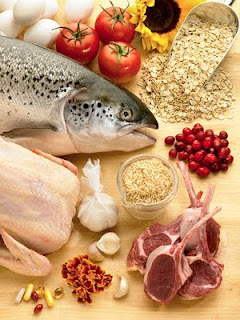Let's first identify the different types of vegetarian diets...
Lacto Ovo Vegetarian
A lacto ovo vegetarian does not eat meat, fish or poultry, however they do eat eggs and milk. They eat eggs and products made with eggs in them as well as yogurt, cheese, milk and ice cream.
Lacto Vegetarian
A lacto vegetarian does not eat meat, fish, poultry or eggs, but they do eat dairy products such as milk, yogurt, ice cream and cheese.
Vegan
A vegan does not eat any fish, meat, poultry, eggs, dairy products or foods that contain any of these products. They typically do not use any non-food items that contain products from animals, including wool from sheep, leather and silk. Vegans often do not eat honey, because bees may be killed while harvesting it. A vegan diet consists of vegetables, grains, beans, nuts, fruits and seeds. This diet tends to be high in fiber and moderate in protein and fat.
Macrobiotics
A macrobiotic diet is mainly vegetarian, but it often includes seafood. Meat, eggs and dairy products are excluded. They also omit "nightshade vegetables", such as potato, pepper and eggplant, as well as refined sugar and tropical fruits. This diet contains many foods found in Asian countries such as miso soup, root vegetables like daikon and lotus, and sea vegetables like seaweed, kelp, and arame.
For babies, children, pregnant and nursing women, a Vegan diet is particularly risky. This is because vegans risk deficiency of three very critical nutrients: protein, vitamins and fish oil.
So let's start with proteins. Not all protein sources are created equal. While plants do have some protein, they are incomplete proteins. Amino acids make up proteins, some of which are essential, meaning the body cannot manufacture them. We need to get those essential amino acids from our food. All plants either lack one or more amino acids, or they contain too little of one. Plant proteins are inferior to animal proteins (meat, fish, milk and eggs) in quantity as there is more protein per calorie in the meat counterparts and they contain amino acids in the *ideal* amounts for human health. Omnivores need complete proteins and they must get them daily because they cannot be stored. Humans are omnivores with bodies designed to eat plant *and* animal foods.
There is a risk of deficiency of essential vitamins with a plant-based diet. Chicken, fish and liver are rich sources of of Vitamin B6, where plants only provide small amounts of that vitamin. Vitamin B12 is found only in animal foods. This is not the only vitamin that is lacking in the Vegan diet, however.
Only animal foods such as seafood, liver, butter and eggs contain "true" vitamins A and D. Humans can make vitamin A from beta-carotene, but it requires much more effort to do so. The conversion also requires bile salts, fats and vitamin E. People with thyroid disorders, as well as babies, children and diabetics are poor converters. We can make some vitamin D in the skin from cholesterol and sunlight when it directly hits our skin but surprisingly, many people don't get enough sunlight and those that do get out in the sun typically lather their skin with sunscreen!
A strict Vegan or vegetarian diet that is void of eicosapentaenoic acid (EPA) and DHA, found only in fish, is a grave risk. These polyunsaturated fatty acids can be made from plant sources like flaxseeds and walnut oil, but humans, especially babies aren't very good at it. According to Loren Cordain, a professor at Colorado State University and an expert in historic diets, says that low DHA in mother or baby causes behavorial, mental and visual problems in infants. Studies show that vegan breast milk is deficient in DHA. Other risks are low birth weight and premature birth.
If you feel you must be a vegetarian, eat real butter, and eggs for a complete protein source, and consume plenty of flaxseed oil. Your need for vitamins A, B12, B6 and D are greater because of the foods you would otherwise limit in your diet. If you want to "make up" for the vitamins lacking in your vegetarian diet, please do not take them in an isolated form (outside of a food source), but do take a quality *whole food* supplement that is made from food, to insure you are meeting your body's nutritional requirements. Talk to me about how you can accomplish being a vegetarian without compromising your body's nutritional demands.
Be healthy And wise
Karen :)






